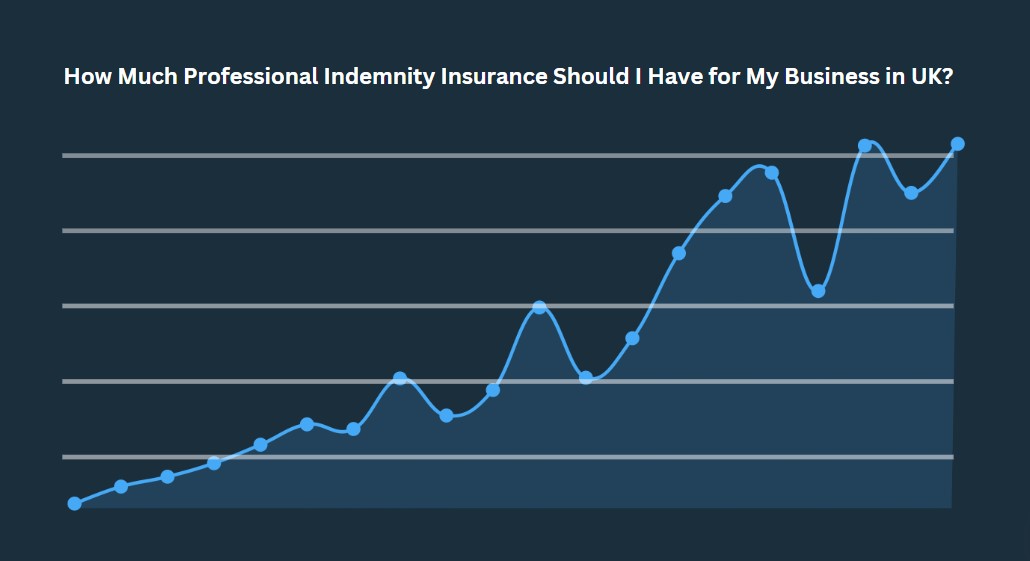Welcome to our guide on professional indemnity insurance coverage amount. Determining the appropriate level of professional indemnity (PI) insurance for your business in the UK is essential in protecting against potential liabilities and claims. As an insurance policy tailored for professionals providing advice or services, PI insurance provides financial protection in the event of mistakes or negligence.
So, the question arises: how much professional indemnity insurance should I have? Let’s see the answer to that.
How Much Professional Indemnity Insurance Should I Have for My Business in UK?
The answer depends on several factors specific to your business and industry. To determine the necessary coverage, it’s crucial to consider the nature of your work, the type of clients you serve, and any minimum requirements set by governing bodies or clients.
Asking clients about their expectations regarding insurance coverage is a good starting point. It can help you understand what level of protection they expect and ensure you meet their requirements. Additionally, calculating the potential cost of rectifying disputes or mistakes is an important consideration when determining the appropriate level of coverage.
The cost of professional indemnity insurance can vary depending on the value of the cover and the specific nature of your work. It’s important to find the right balance between adequate protection and affordability. Insurance providers like Hiscox offer tailored professional indemnity insurance quotes based on the common risks associated with different professions.
Factors Influencing Professional Indemnity Insurance Amount
When determining the recommended PI insurance level or selecting an appropriate professional indemnity insurance limit, it is crucial to consider various factors. These factors include the type of work you engage in, the industry your clients belong to, and the potential cost of rectifying mistakes. Although the size of your business, the size of your clients, and the values of your contracts also play a role, it is important to remember that legal costs should be accounted for when determining your coverage needs.
Understanding how these factors influence the amount of professional indemnity insurance coverage required is essential for protecting your business against potential risks and liabilities. By evaluating these considerations, you can determine the adequate professional indemnity insurance coverage that suits your specific needs and ensures peace of mind.
Assessing Professional Indemnity Insurance Needs
When determining the appropriate level of professional indemnity insurance, it is crucial for businesses to carefully assess their specific needs. By considering factors such as liability, potential risks, and the costs associated with rectifying errors, businesses can make informed decisions about their insurance coverage.
An essential step in this process is evaluating the scope of projects and the value of contracts. Understanding the potential compensation demands in the event of mistakes can provide valuable insights into the level of coverage required. This assessment helps businesses protect themselves against unforeseen liabilities and avoid potential financial hardships.
To calculate the optimal professional indemnity insurance level, it is advisable to consider the worst-case scenarios and estimate the potential costs involved. By evaluating the potential risks and their potential financial implications, businesses can ensure that they are adequately covered.
Additionally, it is important to review industry best practices and recommendations when evaluating professional indemnity insurance needs. Consulting with industry experts or professional bodies can provide valuable insights into common practices and help businesses make informed decisions.
Evaluating Professional Indemnity Insurance Needs:
- Determine the level of liability and the potential risks associated with your business and industry.
- Evaluate the scope of projects and the value of contracts to understand the potential compensation demands in the event of mistakes or errors.
- Estimate the potential costs of rectifying mistakes or errors to determine the necessary coverage level.
- Consider industry recommendations and best practices to ensure your coverage aligns with industry standards.
- Consult with industry experts or professional bodies for guidance on determining the optimal professional indemnity insurance level.
“Determining the appropriate level of professional indemnity insurance is a crucial step for businesses to protect themselves from potential liabilities and financial hardships.”
| Considerations | Factors to Evaluate |
|---|---|
| Liability | The level of risk associated with your business and industry. |
| Project Scope | The size and complexity of the projects you undertake. |
| Contract Value | The total value of contracts your business engages in. |
| Compensation Demands | The potential costs involved in rectifying mistakes or errors. |
| Industry Recommendations | Guidelines and best practices set by professional bodies or industry standards. |

Minimum Requirements and Industry Recommendations
When determining the appropriate level of coverage for your professional indemnity insurance, it is essential to consider any minimum requirements or industry recommendations in your profession or sector. Several professions and industries have specific guidelines in place to ensure adequate coverage and protection.
For example, the Architects Registration Board (ARB) recommends a minimum coverage of £250,000 for its members. This recommendation takes into account the potential risks and liabilities associated with architectural work. By adhering to this minimum requirement, architects can safeguard their practices against potential claims and legal disputes.
Besides professional bodies, certain regulatory authorities may impose specific insurance requirements on businesses. Those regulated by the Financial Conduct Authority (FCA) in the UK, for instance, may be required to hold professional indemnity insurance coverage exceeding £1 million. These additional requirements are designed to protect both businesses and their clients from potential financial losses and legal complications.
By considering these minimum requirements and industry recommendations, businesses can ensure that their professional indemnity insurance coverage aligns with best practices and provides adequate protection in their particular field or sector.
The Architects Registration Board’s Minimum Coverage Recommendation
According to the Architects Registration Board (ARB), architects should have a minimum professional indemnity insurance coverage of £250,000. Failure to meet this recommended coverage level may leave architects financially exposed in the event of errors, omissions, or claims against their work. By maintaining adequate coverage, architects can protect their business and their clients’ interests.

| Profession/Industry | Minimum Coverage Requirement/Recommendation |
|---|---|
| Architects | £250,000 (as recommended by the Architects Registration Board) |
| Financial Services (regulated by the FCA) | Exceeding £1 million (as required by the Financial Conduct Authority) |
| Legal Professionals | Varies based on jurisdiction and type of practice (consult regulatory bodies) |
| Healthcare Professionals | Varies based on the specific role and area of practice (consult relevant bodies) |
| Consultants/Advisors | Varies based on industry, individual contracts, and clients’ requirements |
“Meeting the minimum recommended coverage or requirement is crucial in safeguarding your business from potential financial losses and legal disputes. It demonstrates professionalism and a commitment to meeting industry standards.”
While the provided examples highlight minimum requirements and recommendations in specific professions and sectors, it is crucial for businesses to research and consult relevant professional bodies, regulatory authorities, and industry associations to determine the appropriate level of professional indemnity insurance coverage for their unique circumstances.
Tailoring Professional Indemnity Insurance
Professional indemnity insurance provides businesses with the necessary coverage to protect against potential liabilities and claims. To ensure adequate protection, it is important to tailor the coverage amount according to the specific needs of the business.
When determining the best professional indemnity insurance limit, businesses should consider several factors:
- The nature of their work: Industries and professions have varying levels of risk exposure. A business offering professional advice, such as architects or consultants, may require a higher coverage amount compared to a retail business.
- The potential risks: Assessing the potential risks associated with the business is crucial in determining the coverage amount. This may include considering the likelihood of errors or negligence that could lead to financial loss for clients.
- The potential costs of claims: Evaluating the potential costs of claims is necessary to ensure the coverage amount is sufficient. This includes considering legal fees, compensation amounts, and any additional expenses that may arise during the claims process.
By carefully evaluating these factors, businesses can determine the professional indemnity insurance coverage amount that best suits their needs.
In addition to these considerations, it is important to thoroughly review the policy terms and conditions, ensuring that all potential risks are covered. Working with an experienced insurance broker can help businesses navigate the complexities of professional indemnity insurance and make informed decisions.
“Tailoring the coverage amount to the specific needs of the business is essential to ensure adequate protection against potential liabilities and claims.”
It is worth mentioning that professional indemnity insurance coverage amounts can vary significantly depending on the industry and the size of the business. Businesses should strive to strike a balance between adequate coverage and affordability.
In summary, businesses should carefully assess the nature of their work, potential risks, and costs of claims to determine the best professional indemnity insurance limit. Tailoring the coverage amount to the specific needs of the business is essential to ensure adequate protection against potential liabilities and claims.
Cost of Professional Indemnity Insurance
The cost of professional indemnity insurance varies depending on the value of the cover and the nature of the work. When considering the coverage needed, it is important to prioritize the necessary level of protection. In many cases, the price difference between meeting the upper estimate of necessary cover and a smaller sum is minimal. By calculating professional indemnity insurance needs accurately, businesses can save on costs while ensuring adequate coverage.
Insurers like Hiscox understand the different risks associated with various professions and offer tailored professional indemnity insurance quotes based on these risks. They take into account factors such as the industry, past claim trends, and the level of coverage required. Getting a quote from such insurers can provide businesses with a clearer understanding of the cost implications of different coverage levels.

A Sample Cost Comparison
| Level of Coverage | Annual Premium |
|---|---|
| £100,000 | £350 |
| £500,000 | £450 |
| £1,000,000 | £550 |
As shown in the sample cost comparison table, the premium increases as the level of coverage goes up. However, the difference in premium between the minimum coverage of £100,000 and the higher coverage amounts of £500,000 and £1,000,000 is relatively small. Therefore, it is often advisable for businesses to opt for higher coverage as it provides more comprehensive protection without a significant increase in price.
Specific Requirements and Considerations
When determining the appropriate level of professional indemnity insurance, businesses must take into account specific requirements and considerations that may be applicable to their industry and contracts.
Public Sector Contracts
For businesses that work with the public sector, it’s important to be aware that some contracts may stipulate a minimum level of professional indemnity insurance. These requirements are typically in place to protect the interests of all parties involved and ensure that adequate coverage is in place to address any potential liabilities. Therefore, businesses should carefully review contract terms and conditions to determine the necessary policy limit.
Professional Bodies’ Stipulations
Certain professional bodies, such as those representing architects, accountants, and other regulated professions, may have their own specific stipulations for professional indemnity insurance coverage. These requirements are often designed to uphold professional standards and protect clients’ interests. Therefore, businesses operating within these industries should consult the guidelines and recommendations set forth by their respective professional bodies to ensure compliance.
“We strongly advise our members to hold a minimum level of professional indemnity insurance to protect themselves and their clients. This coverage is essential for mitigating potential risks and ensuring the highest level of professional service.”
– Professional Body Representative
Past Work Implications
Reducing the level of professional indemnity insurance coverage can have implications for past completed projects. Claims and disputes can arise even after the completion of a project, and businesses must have adequate coverage to address any potential liabilities. Therefore, businesses should carefully evaluate the potential risks associated with past work and consider the long-term implications of adjusting the coverage amount.
Overall, businesses should be proactive in understanding and adhering to any specific requirements or considerations related to professional indemnity insurance. By doing so, they can ensure that their coverage is sufficient to meet both industry standards and contractual obligations.
Conclusion
Determining the appropriate level of professional indemnity insurance is a critical decision for businesses. When setting the suitable professional indemnity insurance amount, it is important to consider several key factors. Firstly, the nature of the work and the potential risks associated with it. Understanding your liability and the potential costs of rectifying errors can help guide your decision.
Additionally, businesses should consider the clients they serve. Different industries may have specific requirements or recommendations for coverage, so it’s important to research and evaluate these guidelines. Governing bodies and industry regulations can provide valuable insights into the optimal coverage amount.
Ultimately, businesses should choose a level of coverage that provides adequate protection and peace of mind. By factoring in the relevant considerations such as the nature of the work, potential compensation demands, and minimum requirements, businesses can ensure their professional indemnity insurance policy is set at a suitable limit for their needs.
FAQ
How do I determine the appropriate level of professional indemnity insurance for my business?
The level of professional indemnity insurance needed depends on factors such as the nature of your work, the type of clients you serve, and any minimum requirements set by governing bodies or clients. Asking clients about their expectations and considering the potential cost of rectifying disputes can help determine the necessary coverage.
How do I assess my professional indemnity insurance needs?
To assess your professional indemnity insurance needs, you should consider your liability, the potential risks associated with your work, and the potential costs of rectifying errors. Evaluate the scope of your projects, the value of your contracts, and the potential compensation demands in the event of mistakes. The level of coverage should be determined based on these factors.
Are there any minimum requirements or recommendations for professional indemnity insurance?
Some professions and industries have minimum requirements or recommendations for professional indemnity insurance coverage. For example, the Architects Registration Board recommends a minimum coverage of £250,000 for its members. Businesses regulated by the Financial Conduct Authority may be required to hold more than £1 million of cover. It is important to consider these minimum requirements or recommendations when determining the appropriate level of coverage.
Can professional indemnity insurance be tailored to my business’s specific needs?
Yes, professional indemnity insurance can be tailored to the specific needs of your business. By considering the nature of your work, the potential risks, and the potential costs of claims, you can determine the best coverage limit for your professional indemnity insurance policy. It is important to ensure that the coverage amount adequately protects against potential liabilities and claims.
Are there any specific requirements or considerations for professional indemnity insurance?
Yes, some contracts, particularly in the public sector, may require a minimum level of professional indemnity insurance. Certain professional bodies, such as those for architects and accountants, may also have specific stipulations for coverage. Businesses should also be aware that reducing the level of cover can have implications for past work, as claims can arise from completed projects. It is important to consider these specific requirements and factors when determining the appropriate level of professional indemnity insurance.




